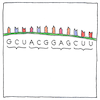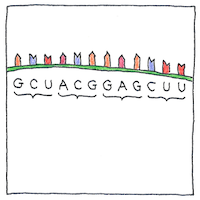Thomas Hunt Morgan, Nettie Maria Stevens, Alfred Henry Sturtevant,
Calvin Bridges, Hermann Joseph Muller
genetics

|
Genes
Thomas Hunt Morgan asserted that heredity factors, as Gregor Mendel has said, are not always independent of one another, but that some genes are dominant, some recessive, and genes that remain together are more likely to come from the same chromosome. Morgan also found the first gene responsible for a defect, the white eyes in a mutant fruit fly in his laboratory at Columbia University where his students made great advances. Nettie Maria Stevens was the first to link differences in chromosomes to a difference in attributes. She studied chromosomal basis for gender in fruit flies and was the one to introduce the fruit fly into Morgan’s lab. Alfred Henry Sturtevant constructed the first genetic map of a chromosome by breeding many flies with different features. Nettie Stevens and Calvin Bridges proved that chromosomes contained the genes responsible for heredity. Hermann Joseph Muller discovered that X-rays could cause mutations that were useful for studying genes.
Drosophila melanogaster
Some among the lowly fruit flies just want to have fun. Some, being more in the family way, want to lay eggs in a warm damp piece of fruit. Knowing that one will die in captivity one yearns to be free, or at least to mate frequently.
Family is an analog
of society. A barber once told me a correlation existed between heart disease and attached ear lobes. In my family ear lobes hang free, so I was inclined to believed him. Over the years, my preference for ear lobes like ours has grown even though I know it’s silly and probably dumb. What if I were hiring and the best candidate had attached ear lobes? What if my child were to love someone with attached ear lobes? Rather than admit it, I would secretly feel the tragedy of ear lobes. Looking for ear lobe attachments can become an obsession. It’s too easy to become convinced of our prejudices, but it’s dangerous to act on them. We can improve our lives but not each other. What starts out as love can end up as brutality. Why is it so hard to love our brothers and sisters?



Although scientists understood the role of chromosomes in inheritance from the mid-1880s, the work of Gregor Mendel was not rediscovered until 1900. Chromosomes were visible in microscopes, but genes could be observed only indirectly. A gene corresponds to a section of the deoxyribonucleic acid molecule (DNA) that forms the nucleus of each cell in the body. The DNA is tightly packed to form chromosomes. The structure of the DNA molecule was not discovered until 1953.
Based on his observation that his mutant fruit fly with white eyes was the offspring of red-eyed parents, Thomas Hunt Morgan argued that eugenics was not entirely scientific. Understanding the genetic effects of X-rays led Sturtevant and Muller to warn of the dangers of radioactive fallout from nuclear testing and nuclear war. But Sturtevant and Muller did not agree on the value of eugenics.
The pseudo-science of eugenics is intermingled with the development and demise of the eugenics movement, which co-opted many well-meaning scientists with the hope of improving humankind, and degenerated into brutal and stupid acts of racial and ethnic hatred, including the genocidal crimes of the Nazis.
The key problems with eugenics are our inability to objectively determine what genetic differences are improvements, and our weakness for using coersion and brutality to get what we want.
See also in The book of science:
Readings in wikipedia: